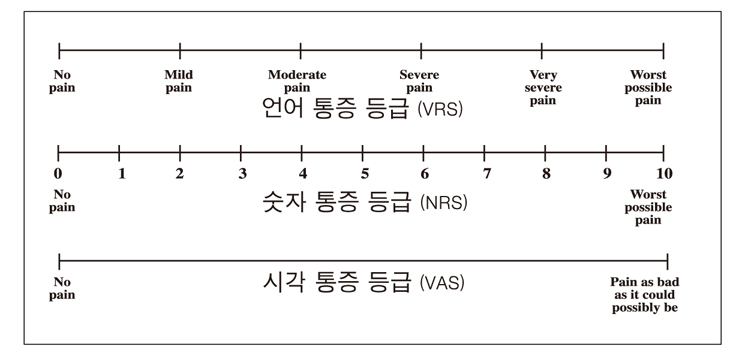J Korean Med Assoc.
2007 Dec;50(12):1090-1095. 10.5124/jkma.2007.50.12.1090.
Postoperative Analgesia
- Affiliations
-
- 1Department of Anesthesiology, Seoul National University College of Medicine, Korea. bahkjh@plaza.snu.ac.kr
- KMID: 2184957
- DOI: http://doi.org/10.5124/jkma.2007.50.12.1090
Abstract
- Uncontrolled or inadequately controlled postoperative pain may lead to delayed recovery from surgery, pulmonary complications, and restriction of mobility leading to increased risk of thromboembolism. Standardized regimens for pain management can lead to safer and better pain control. Of these regimens, patient-controlled analgesia, a delivery system with which patients self-administer small, predetermined analgesic doses, produced improved pain relief, greater patient satisfaction, less sedation, and fewer postoperative complications. Anesthesiologists have played an important role to make this pain management feasible. The introduction of acute pain services at hospitals prompted improvements in postoperative pain management in addition to the minimization of related complications.
Keyword
MeSH Terms
Figure
Reference
-
1. Reuben SS, Buvanendrain A. Preventing the development of chronic pain after orthopaedic surgery with preventive multimodal analgesic techniques. J Bone Joint Surg Am. 2007. 89:1343–1358.
Article2. Waldman SD. Pain Management. 2007. 1st ed. Philadelphia: Saunders;200.3. The Korean Pain Society. Pain Medicine. 2007. 3rd ed. Seoul: Koonja Publishing;33–50.4. Benzon HT, Raja SN, Molloy RE, Liu SS, Fishman SM. Essentials of Pain Medicine and Regional Anesthesia. 2005. 2nd ed. Philadelphia: Elsevier;29–34.5. Buvanendran A, Reuben SS, Kroin JS. Recent advances in nonopioid analgesics for acute pain management. Tech Reg Anesth Pain Med. 2007. 11:19–26.
Article6. Australian and New Zealand College of Anaesthetists and Faculty of Pain Medicine. Acute pain management: scientific evidence. 2005. 2nd ed. http://www.anzca.edu.au/resources/books-and-publlications.7. Remy C, Marret E, Bonnet F. State of the art of paracetamol in acute pain therapy. Curr Opin Anaesthesiol. 2006. 19:562–565.
Article8. Bollish SJ, Colllins CL, Kirking DM, Bartlett RH. Efficacy of patient-controlled versus conventional analgesia for postoperative pain. Clin Pham. 1985. 4:48–52.9. Walder B, Schafer M, Henzi I, Tramèr MR. Efficacy and safety of patient-controlled opioid analgesia for acute postoperative pain: a quantitative systemic review. Acta Anaesthesiol Scand. 2001. 45:795–804.
Article10. Culebras X, Corpataux JB, Gaggero G, Tramèr MR. The antiemetic efficiency of droperidol added to morphine patient-controlled analgesia: a randomized, controlled, multicenter dose-finding study. Anesth Analg. 2003. 97:816–821.11. Gan TJ, Meyer T, Apfel CC, Chung F, Davis PJ, Eubanks S, Kovac A, Philip BK, Sessler DI, Temo J, Tramèr MR, Watcha M. Consensus guidelines for managing postoperative nausea and vomiting. Anesth Analg. 2003. 97:62–71.
Article12. Momeni M, Crucitti M, De Kock M. Patient-Controlled Analgesia in the Management of Postoperative Pain. Drugs. 2006. 66:2321–2337.
Article13. Lynch EP, Lazor MA, Gellis JE, Orav J, Goldman L, Marcantonio ER. The impact of postoperative pain on the development of postoperative delirium. Anesth Analg. 1998. 86:781–785.
Article14. Dolin SJ, Cashman JN. Tolerability of acute postoperative pain management: Nausea, vomiting, sedation, pruritus, and urinary retention. Evidence from published data. Br J Anaesth. 2005. 95:584–591.
Article15. Lim YJ, Bahk JH, Ahn WS, Lee SC. Coiling of lumbar epidural catheters. Acta Anaesthesiol Scand. 2002. 46:603–606.
Article16. Ryu HG, Bahk JH, Lee CJ, Lim YJ. The coiling length of thoracic epidural catheters: the influence of epidural approach angle. Br J Anaesth. 2007. 98:401–404.
Article
- Full Text Links
- Actions
-
Cited
- CITED
-
- Close
- Share
- Similar articles
-
- Postoperative Analgesia by Epidural Morphine Injection
- Comparison of Postoperative Analgesia and Side Effects by Patient-Controlled Epidural and Intravenous Analgesia after Cesarean Section
- The Effect of Intraarticular Morphine and Clonidine on Postoperative Analgesia after Knee Surgery
- Comparison of the Effects of Postoperative Continuous Plus Bolus Patient-Controlled Analgesia and of Bolus Patient-Controlled Analgesia in Children
- Caudal Epidural Morphine for Postoperative Analgesia in Children


